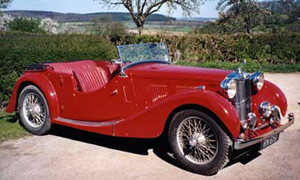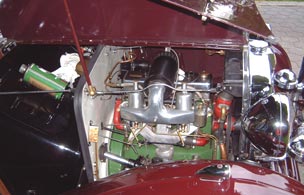During the introduction of the Two Litre MG SA, it was established that there would also be a market for a smaller version along similar lines. So when production of the Two Litre had started in March 1936 the development of its smaller brother was already in progress. At the 1936 October Olympia Motorshow the “One And A Half Litre”, generally better known as “the VA” was introduced to the public.
The VA was available in three models, a 4 door Sport Saloon, a 2 door 4 seater Tourer as well as a Folding Head Foursome, generally known as a Tickford by Salmons & Sons. (See the VA Gallery for some original MG factory photos of VAs).
Shared Technology
The new VAs were available for customers from April 1937 until the outbreak of WW2, with a total production of 2,407 cars.
The VA shared a lot of the technology with the SA and the TA, in particular the cast iron overhead valve pushrod engines, the ash framed body, the twin SU carburetors, the wire wheels, hydraulic brakes and semi-synchro gearbox. It had a sturdy but sporty chassis incorporating MG’s racing experience, and very good road holding for a pre-war car, a true MG. Although much bigger than the TA sports car, it was light and short in comparison with the SA, and the power/weight ratio was certainly no worse making it more sprightly to handle.

VA Tourer
All VAs had well appointed interiors with comfortable seating for four adults and adequate luggage space on the Saloon and Tickford. The impressive dashboard was shared with the SA.
We do not know who by name was responsible for the design, it is likely that the car just appeared as a reduced version of the larger car. Some of the imposing style of the SA was inevitably lost in the VA, the long bonnet line in particular. The car has a more ‘dumpy’ and cheerful appearance, but is more in the sporting tradition of the marque than the SA.
The 4 cylinder engine TPBG Type engine was developed from the 69.5 X 102 mm Morris 12 unit but with overhead valves, a higher compression ratio and with twin SU 1¼” HV3 carburettors was capable of producing 54 horsepower. Starting off with a cork lined clutch running in oil, from engine number TPBG 1510 a dry single plate clutch was fitted. The engine (details below) was more powerful than the 1350cc four cylinder fitted to the TA sports car. Consequently, it was fitted as a special by the factory to the TA for competitive events, the best-known cars of this type being the Three Musketeers and the Cream Crackers.
Standard Engine
- TPBG Type 4 cylinders in line, with three main bearings, fully counter balanced crankshaft from TPBG 1891 (13.09.38), late models with shell bearings instead of white metal.
- Twin SU 1 ¼” Carburettors.
- Bore 69.5mm, stroke 102mm, capacity 1548cc.
- Rating 11.98hp, maximum power 54bhp at 4500rpm.
- Maximum torque 74.316ft at 2600rpm, RAC rating 11.98hp.
Bored Out Engine
TPDG and TPBG.RS types, as above, except:-
- Twin SU 1 ½” Carburettors
- Bore 73mm, capacity 1707cc
- Rating 13.22hp, maximum power 61.7bhp at 4200rpm RAC rating 13.22hp. Special distributor and timing retarded 5%.

VA Tourer engine bay
Technical spec was high for those days with 12 volt electrics, automatic charge control, automatic advance/retard, hydraulic shock absorbers that could be adjusted for ride from the drivers seat on the earlier models, oil level check from the dashboard, petrol gauge, brake torque reaction controlled front axle, reversing lamp. For a mere £5 extra a Smith Jackall system was fitted.
By today’s standards 54 hp does not seem a lot but they propel you in great comfort and relative silence. The road holding is so good that slowing down for corners is hardly needed and the car is a great deal more responsive than the SA and WA. In standard form any VA is happy to cruise along at 55-60 mph for hours on end. Contemporary road tests repeatedly speak about top speeds in excess of 80 mph but that is regarded as a bit too enthusiastic these days.
Like the SA, the car was favoured as a police vehicle. MG offered an up-rated car for this purpose, with a more powerful engine (see above). Chassis V 2126 was the VA developed by MG for the police to try and it is still on the road in Norfolk.
MG was forbidden to directly support racing events, but in any event, the VA was not really sporting enough to be used competitively, though it did appear in Road Races such as in Brighton and in Concours events. For mud-plugging and off-road events, so popular before the war, the TA and its successors were used, though as mentioned, the faster of these had the VA engine.
Today the VA is seen as a most attractive MG, especially the open versions that are in big demand for growing families for which the Midgets are getting too small. A lot of the open cars have survived and are great fun to drive. They can keep up with modern traffic, the road holding and steering is good, and the brakes well up to the job. Cruising on motorways, as with all SVW cars, is perfectly possible, though at truck speeds-the long stroke, low geared tradition of all pre-war UK cars limiting the high speed cruising of which the car is otherwise capable.
